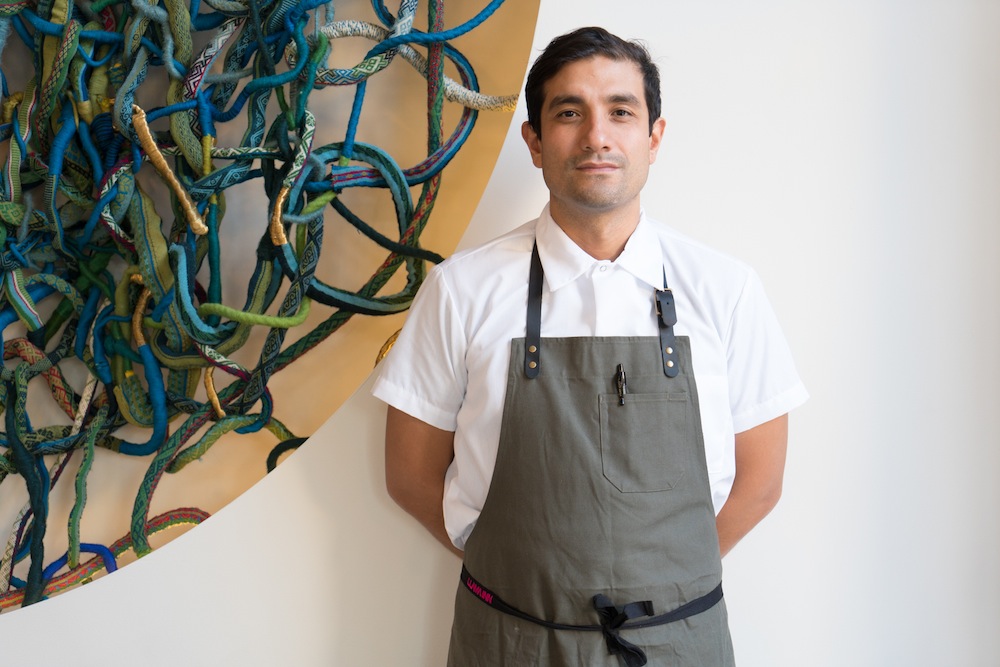Is Peru for you? If you don’t yet know the answer and/or if you didn’t answer “yes,” [insert expression of shock, horror, and disbelief] then get thee to Llama Inn as fast as your MTA MetroCard will take you.
Llama Inn, the whimsical Williamsburg meets Peru restaurant opened by Chef Erik Ramirez late last year (and whose roof deck is slated to open next month for its inaugural summer season), pays homage to the foods and flavors of Ramirez’s childhood while adding a modern – and decidedly playful – twist.
Before opening Llama Inn, Ramirez cut his teeth at New York’s Raymi and Eleven Madison Park, among others. The combination of his culinary prowess and surprising mash-up of ingredients and influences is the one-two punch that makes Llama Inn a must-visit for curious eaters eager to learn more about what’s happening in Peruvian food right now.
We chatted with Ramirez last week and asked him about his definition of stoner food, what he learned while cruising Peru with chef Virgilio Martinez, if he’s seen any crazy [stuff] happening under the bridge since moving into his digs below the BQE, and how he rates his Williamsburg patrons’ knowledge of Peruvian food. (Ramirez is himself a Williamsburg-er; he even rides his bike to the restaurant.) Here’s what he had to say about these subjects and more. [pagebreak]
The Latin Kitchen: Scale of 1-10, where would you put your guests’ knowledge of Peruvian food? And then, where do you see yourself in changing or advancing that number?
Chef Erik Ramirez: It varies, but for [Williamsburg] I’d say 5. I hope I can open some people’s eyes to look at Peruvian food in a different light. It’s not all chicken and ceviche. Just from constantly evolving and making Llama better, I hope people can catch on and see the potential Peruvian cuisine has.
TLK: You’ve called your brunch menu “fun, stoner food?” What is your definition of “fun, stoner food?”
ER: Ha! I meant that loosely. It’s not typical items you find on a brunch menu. When I say “fun” I guess I mean new, and new things are exciting for people who haven’t eaten stuff like this for brunch. It’s food you want to dig into and savor each bite. For example, the omelet stuffed with Chinese sausage fried rice; Who wouldn’t want to eat that after a night of partying?
TLK: What did you learn while traveling and cooking with chefs Virgilio Martínez and Diego Munoz in Peru, whether about cooking or ingredients or life in general?
ER: I spent time at Central and Astrid & Gaston for five days each in November 2015. I spent about a month in Peru and had some great experiences gaining good insights from the trip. I’ve actually known Virgilio for a few years now. We met on one of my many trips to Peru as a chef. I learned about new ingredients and different flavor profiles. And how much Peruvian cuisine has evolved.
There is such exciting food in Peru and I want to share that with people who have no idea. It’s also important to never stay stagnant and always be pushing the boundaries of what people think is possible.
What interested me the most about Llama Inn was that I was able to showcase Peruvian cuisine through my perspective; that I can bridge the gap between NYC and Peru, bring those two styles of cuisine and cooking together. It’s New York cooking with a Peruvian attitude and heartbeat. I knew it was going to translate because the flavor profiles of Peruvian cuisine are delicious. Delicious is delicious no matter what continent you are on. [pagebreak]
TLK: Though some of the dishes on your menu are classic Peruvian, albeit with a modern, global twist, you don’t write them in Spanish. The Lomo Saltado, for example. Is there a reason for that?
ER: Yes, so it’s more accessible to a larger audience.
TLK: What’s your favorite dish on the menu? Like, the thing you would eat every day if you had to.
ER: That’s a tough one. I’m gonna’ have to go with two items. Ceviche – not a specific one but ceviche in general – and probably Lomo Saltado (beef tenderloin stir fry).
TLK: Open kitchens have kind of a performance art quality. Is there pressure to be “entertaining” when you work in an open kitchen?
ER: Not so much entertaining but more on being careful on what you do because people are watching. No double dipping, using tasting spoons, no arguing or yelling, working cleaned and organized. Acting like adults. When behind closed doors the kids can get carried away. [pagebreak]
TLK: You attended the Art Institute of Philadelphia before becoming a chef. What would you be doing if you weren’t cooking for a living?
ER: Not sure, I always think about that. Maybe something with music.
TLK: It’s an interesting location for Llama Inn – on a remote corner under the Brooklyn Queens Expressway (BQE) between two super-gentrified hipster hubs. Why not open in one of Williamsburg’s “trendier” sections?
ER: It’s an up and coming neighborhood. The restaurant is on the corner and when we found the space we knew it was the right one.
TLK: Have you seen anything really weird happen “under the bridge” (aka the BQE overpass)?
ER: No not really, just a lot of skate boarding.
TLK: Whose job is it to water the couple dozen plants that line the perimeter of Llama Inn?
ER: The AM dishwasher. He waters the plants every Tuesday and Thursday.


![Making Mealtime Matter with La Familia: Easy Sofrito [Video]](https://thelatinkitchen.com/wp-content/uploads/2015/10/sofrito-shutterstock__0-500x383.jpg)
![Easy Latin Smoothies: Goji Berry Smoothie [Video]](https://thelatinkitchen.com/wp-content/uploads/2015/12/goji_berry-shutterstock_-500x383.jpg)
















![Fun and Fast Recipes: Fiesta Cabbage Salad [Video]](https://thelatinkitchen.com/wp-content/uploads/2015/11/fiesta_cabbage_slaw-shutterstock_-500x383.jpg)









